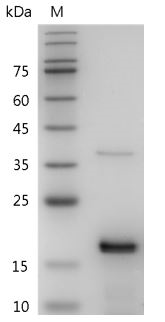| Product name | Mouse/Rat FGF-2 protein, His tag (Animal-Free) |
| Sequence | Amino acid sequence derived from Mouse/Rat FGF-2 protein (Ala11-Ser154) with 6×His tag at the N-terminus was expressed |
| Applications | His tag |
| Applications notes | Mouse/Rat |
| Activity | Measure by its ability to induce 3T3 cells proliferation.The ED₅₀ for this effect is <1.5 ng/mL.The specific activity of recombinant mouse FGF-2 is approximately >1 x 10⁶ IU/mg. |
| Protein length | The recombinant Mouse/Rat FGF-2 consists of 144 amino acids and predicts a molecular mass of 17.2 kDa |
| Preparation method | E. coli |
| Purity | >98% as determined by SDS-PAGE. |
| Alternative | HBGF-2, Prostatropin |
| Formulation | The protein was lyophilized from 0.01% sarkosyl in 1X PBS, pH 8.0. If you have any concerns or special requirements, please confirm with us. |
| Features & Benefits | Endotoxin:<0.1 EU per 1 μg of the protein by the LAL method. |
| Molecular weight | The protein has a calculated MW of 17.2 kDa.The protein migrates as 19 kDa under reducing condition (SDS-PAGE analysis). |
| Usage notes | Always centrifuge tubes before opening. It is recommended to reconstitute the lyophilized recombinant |
| Storage instructions | Lyophilized protein product should be stored desiccated below -18°C. Upon reconstitution, the protein should be stored at 4°C between 2-7 days and for future use below -18°C. For long term storage it is recommended to add a carrier protein (5% HSA , 10%FBS or 0.1%BSA). Please prevent freeze-thaw cycles |
| Shipping | Gel pack with blue ice. |
| Precautions | The product listed herein is for research use only and is not intended for use in human or clinical diagnosis. Suggested applications of our products are not recommendations to use our products in violation of any patent or as a license. We cannot be responsible for patent infringements or other violations that may occur with the use of this product. |
| Background | FGF-2 (FGFb, fibroblast growth factor basic) belongs to the fibroblast growth factor (FGF) family, and interacts with high-affinity transmembrane receptors to influence cell proliferation and tissue neovascularization. FGF-2 exists as five isoforms with distinct intracellular localizations and functions. The 18 kDa isoform is predominantly cytosolic and acts through cell surface receptors, whereas the 22, 22.5, 24 and 34 kDa isoforms are nuclear and may signal independent of transmembrane receptor pathways. FGF-2 has been implicated in diverse biological processes, such as limb and nervous system development, wound healing, and tumor growth. |
| Alternative | HBGF-2, Prostatropin |
| Accession | P15655(Mouse), P13109.1(Rat) |

Fig.SDS-PAGE analysis of Mouse/Rat FGF-2 protein
You must be logged in to post a review.
Reviews
There are no reviews yet.